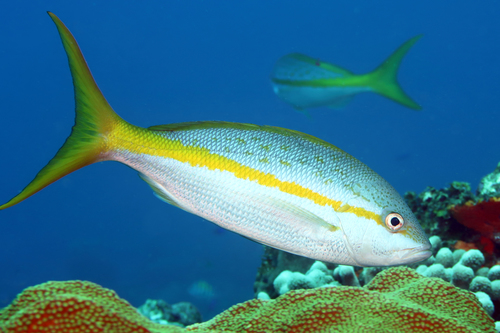
Yellowtail Snapper
The Atlantic bluefin tuna (Thunnus thynnus) is a majestic and highly migratory species of tuna found in the Atlantic Ocean. Renowned for its size, speed, and commercial value, it plays a crucial role in marine ecosystems. This species faces significant conservation challenges due to overfishing.
3 17 years
Lifespan
86.3 cm
Length
Near Threatened
Conservation Status
Carnivorous, Planktivorous
Diet
Local Migration
Migration
Appearance Overview
The Atlantic bluefin tuna is renowned for its large, streamlined body, built for speed and endurance.
Color
Dark metallic blue above, silvery white below
Fins
Two dorsal fins, the first depressible into a groove; short pectoral fins
Body shape
Torpedo-shaped, robust body
Length
Up to 13 feet (4 meters)
Weight
Up to 2,000 lbs (907 kg)
Diet
Carnivorous, feeding on a variety of fish, squid, crustaceans, and eels.
Feeding Behavior
Highly opportunistic predators, they use their speed and agility to hunt, often feeding near the surface but also diving deep.
Social Behavior
Forms large schools, especially during migration and spawning; known for long-distance migrations across oceans.
Commercial Relevance
Extremely high value, particularly in the sushi and sashimi markets, where it is considered a delicacy.
Conservation measures
Subject to international fishing quotas, stock management plans, and monitoring efforts by organizations like ICCAT.
Status
Endangered
Threats
Historically severe overfishing, bycatch in fisheries targeting other species, and habitat degradation.
Habitat Distribution
Depth Range
0-1,000 meters, though they are most commonly found in the upper layers of the ocean.
Geographic Range
Primarily found in the Atlantic Ocean, including the Mediterranean Sea; populations exist in the western and eastern Atlantic.
Preferred Environment
Prefers temperate and subtropical waters; undertakes seasonal migrations to warmer waters for spawning.
Reproduction and Life Cycle
Breeding Habits
Spawns in warm waters, primarily in the Mediterranean Sea and the Gulf of Mexico; spawning occurs from May to August.
Development Stages
Eggs hatch into larvae that drift with the currents; juveniles grow rapidly, forming schools as they mature.
Fecundity
Females can release up to 30 million eggs per spawning season, depending on their size and condition.
Maturity Age
Reaches sexual maturity at around 4-8 years in the eastern Atlantic and Mediterranean, and later (around 9-13) in the western Atlantic.
Faqs about Yellowtail Snapper
How far do Atlantic bluefin tuna migrate?
Atlantic bluefin tuna are highly migratory, capable of crossing the entire Atlantic Ocean in a matter of months.
What is the lifespan of an Atlantic bluefin tuna?
They can live up to 40 years, though many are caught before reaching this age.
Is fishing for Atlantic bluefin tuna regulated?
Yes, there are regulations and quotas in place, but enforcement and compliance vary by region.
Why are Atlantic bluefin tuna considered top predators?
Their size, speed, and powerful muscles make them formidable predators in the ocean.
How do Atlantic bluefin tuna adapt to different water temperatures?
Atlantic bluefin tuna have a unique ability to maintain a body temperature higher than the surrounding water, which helps them survive in a wide range of temperatures.
Copyright @ Nature Style Limited. All Rights Reserved.
 English
English